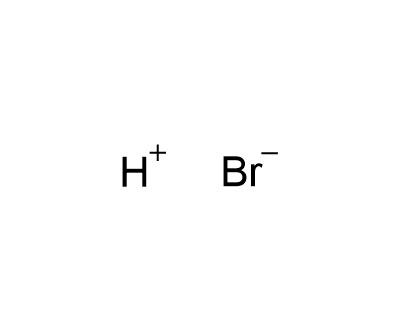

Hydrogen bromide is a binary compound with the chemical formula HBr, which is typically a gas. Hydrogen bromide dissolves in water to obtain hydrobromic acid, and adding a dehydrating agent to hydrobromic acid can also obtain hydrogen bromide.
| Chinese name | 氢溴酸 | English name | hydrogen bromide |
|---|---|---|---|
| Chinese alias | 溴化氢; | English alias | Bromwasserstoff;acidobromhidrico;Bromowodor;Broomwaterstof;HBR; 查看更多英文别名 |
| CAS | 10035-10-6 | Molecular formula | BrH |
| Molecular weight | 80.91190 | Accurate mass | 79.92620 |
| PSA | 0.00000 | LOGP | 0.95810 |
| EINECS | 233-113-0 |
|---|---|
| MDL | MFCD00011323 |
| PubChem | 24851252 |
| RTECS | MW3850000 |
| BRN | 3587158 |
Appearance and characteristics:
Colorless gas with a pungent and suffocating odor
Density:
1.49 g/mL at 25 °C(lit.)
Boiling point:
−67 °C(lit.)
Melting point:
−87 °C(lit.)
Flash point:
40°C
Refractive index:
n20/D 1.438
Water solubility:
soluble
Stability:
Stable. Incompatible with strong bases, strong oxidizing agents, ammonia, ozone, fluorine, water, metals. Air and light sensitive.
Storage conditions:
The warehouse is ventilated, low-temperature, and dry, and stored separately from cyanide, H-pore forming agents, and alkalis
Steam density:
2.8 (vs air)
Steam pressure:
654mmHg at 25°C
RTECS:
MW3850000
Safety instructions:
S26-S45-S7/9
WGK Germany:
one
Hazard category code:
R10; R34; R37
Dangerous goods transportation code:
UN 3265 8/PG 2
Customs code:
two billion eight hundred and eleven million one hundred and ninety-nine thousand and ninety
Hazard category:
eight
Packaging grade:
II
Dangerous goods signs:
C
Hazard prevention instructions:
P260; P280; P303 + P361 + P353; P304 + P340 + P310; P305 + P351 + P338; P410
Signal words:
Danger
Hazard description:
H280; H314; H335
Danger signs:
GHS04, GHS05, GHS07
1. The red phosphorus method first places red phosphorus into a reactor filled with water, slowly adding bromine under stirring, and reacting to produce hydrobromic acid and hypophosphite. The hydrobromic acid product is obtained through sedimentation, filtration, and distillation. The reaction equation is as follows:
2. The sulfur dioxide method involves introducing sulfur dioxide into a reaction vessel containing bromine and crushed ice, and maintaining the temperature below 20 ℃ for the reaction until the solution turns yellow. Distillation is performed on the mixed solution, and the distilled solution is added to a barium hydroxide solution to react with the generated sulfuric acid, resulting in the formation of barium sulfate precipitate. After settling, filtering, removing the precipitate, and distilling the filtrate, the finished product of hydrobromic acid is obtained. The reaction equation is as follows:
3. Bromine and hydrogen are directly synthesized into hydrogen bromide in the presence of activated carbon catalyst. Then distill and purify to produce hydrogen bromide. The reaction equation is as follows:
4. Bromide benzene in the presence of catalyst FeBr3. Place 200g of anhydrous benzene and a few grams of iron bromide (or iron powder) in a flask, then use a paraffin coated stopper to close the flask. A dropper funnel and exhaust pipe are inserted into the stopper, and 135mL of bromine is slowly added through the dropper funnel (under negative pressure). At this point, a violent reaction will occur (the flask should be cooled with water) and hydrogen bromide will be evenly released. The gas that comes out passes through a U-shaped tube, with one end filled with FeBr3 to absorb benzene and the other end filled with anthracene to combine with the bromine produced. Bromine reacts with red phosphorus containing water. Put 10g of red phosphorus and 20mL of water into the flask. Slowly add 35mL of bromine through a dropper funnel under negative pressure. In order to purify the gas, it is passed through a U-shaped tube filled with a mixture of asbestos and water containing (but not wet) red phosphorus. The purified hydrobromic acid is extracted with chloroform and the aqueous phase is separated for distillation. At 62 ℃, a small amount of chloroform was evaporated, and at 125-126 ℃, hydrobromic acid (relative density 1.4) was evaporated
73).
5. Add 120 grams of powdered potassium bromide to 200 milliliters of water. Place the container in cold water and slowly add 90 milliliters of concentrated sulfuric acid (1.7 moles). The temperature should not exceed 75 ℃, otherwise a small amount of free Australian will be generated. However, generating a low t odor is not important as it will be distilled out during the distillation process along with fractions with boiling points between 100-115 ℃. Cool the solution to room temperature and filter out potassium sulfate in a glass funnel. Place the filtrate in a 500ml distillation flask, add a water condenser and receiver, and heat it on a wire mesh. The presence of 0.01-0.015% sulfate ions in the solution does not hinder the retention of the distilled radium solution, which has a boiling point 1 ℃ lower than that of the azeotropic mixture. Distillation should be stopped immediately when the temperature drops. The specific gravity of a solution can change because the composition of the distillate changes with atmospheric pressure, resulting in a yield of approximately 85%. Further distillation of low boiling fractions can increase the yield. If a boiling solution without sulfate ions is required, the distillate should be collected at a temperature 5 ℃ lower than that of the constant boiling solution, and the acid should be distilled again. Only the solution distilled at the constant boiling point should be collected to obtain the constant boiling acid with the highest specific gravity. Adding barium hydroxide before the second distillation does not produce a purer product. The yield is approximately 86% of the computational cost. Distillation of hydrobromic acid with stannous chloride yields colorless hydrobromic acid.
Used for manufacturing various bromine compounds, as well as in industries such as pharmaceuticals, dyes, and fragrances.